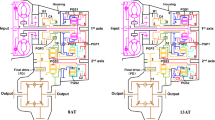Abstract
The braking system of hybrid electric vehicle (HEV) is composed of friction and regenerative braking system, meaning that braking torque is generated by the collaboration of the friction and regenerative braking system. With the attributes, there are two problems in the HEV braking system. First, rapid deceleration occurs due to dynamic characteristic difference when shifting the friction and regenerative braking systems. Second, the friction braking torque alters with temperature because the friction coefficient changes with the temperature. These problems cause the vehicle to be unstable. In this paper, the concurrence control and compensation control were proposed to solve these problems. And also, the concurrence control and compensation control were combined for the stability of the braking system. In order to confirm the effect of these control algorithms, the experiment and simulation were conducted. Consequently, it was confirmed that the control algorithm of this study improved the vehicle safety and stability.
Similar content being viewed by others
References
Balotin, J. G., Neis, P. D. and Ferreira, N. F. (2010). Analysis of the influence of temperature on the friction coefficient of friction materials. ABCM Symp. Series in Mechatronics, 4, 898–906.
Cho, B. K. (2011). Reliability Test of the Electronic Brake System for the Green Car. M. S. Thesis. Sungkyunkwan University. Suwon, Korea.
Esposito, A. (2008). Fluid Power with Applications. 7th edn. Prentice Hall. Upper Saddle River, New Jersey, USA.
Gao, C. H. and Lin, X. Z. (2002). Transient temperature field analysis of a brake in a non-axisymmetric threedimensional model. J. Mater. Process. Technol., 129, 513–517.
Geng, B., Mills, J. K. and Sun, D. (2014). Combined power management/design optimization for a fuel cell/battery plug-in hybrid electric vehicle using multi-objective particle swarm optimization. Int. J. Automotive Technology 15, 4, 645–654.
Golnaraghi, F. and Kuo, B. C. (2009). Automatic Control Systems. 9th edn. John Wiley & Sons. New York.
Hong, S., Kim, H. and Kim, J. (2015). Motor control algorithm for an optimal engine operation of power split hybrid electric vehicle. Int. J. Automotive Technology 16, 1, 97–105.
Incropera, F. P., Dewitt, D. P., Bergman, T. L. and Lavine, A. S. (2006). Fundamentals of Heat and Mass Transfer. 6th edn. John Wiley & Sons. New York.
Jo, C., Ko, J., Yeo, H., Hwang, S. and Kim, H. (2012). Cooperative regenerative braking control algorithm for an automatic-transmission-based hybrid electric vehicle during a downshift. Proc. Instn. Mech. Engrs., Part D: J. Automobile Engineering 226, 4, 457–467.
Jun, K. J., Jung, S. P., Yoon, J. W., Jeon, Y. H., Park, T. W. and Yoon, J. H. (2006). Numerical prediction of the brake components temperature rise using friction heat division and conduction. Fall Conf. Proc., Korean Society of Automotive Engineers, 904–909.
Ko, J. W., Ko, S. Y., Hyun, D. Y. and Kim, H. S. (2014). Co-operative control for regenerative braking and friction braking to increase energy recovery without wheel lock. Int. J. Automotive Technology 15, 2, 253–262.
Kwon, M. H., Park, J. H., Gwak, G. S., Huh, J. W. and Hwang, S. H. (2014). Temperature comparison between friction and regenerative braking system using finite difference method. KSAE Annual Conf. Proc., Korean Society of Automotive Engineers, 1330–1331.
Kwon, M. H., Park, J. H., Gwak, G. S., Huh, J. W. and Hwang, S. H. (2015). Cooperative control algorithm for friction and regenerative braking systems considering temperature characteristics. Proc. EVS28, KINTEX, Korea.
Lee, K. J. (1999). Numerical prediction of brake fluid temperature rise during braking and heat soaking. SAE Paper No. 1999-01-0483.
Limpert, R. (1999). Brake Design and Safety. 2nd edn. SAE. Warrendale, Pennsylvania, USA.
Nam, K. H. (2010). AC Motor Control and Electric Vehicle Applications. CRC Press. Boca Raton, USA.
Sciarretta, A. and Guzzella, L. (2007). Control of hybrid electric vehicles. IEEE Control Systems 27, 2, 60–70.
Yang, Y., Zou, J., Yang, Y. and Qin, D. (2014). Design and simulation of pressure coordinated control system for hybrid vehicle regenerative braking system. J. Dynamic Systems, Measurement, and Control 136, 5, 051019.
Yeo, H., Hwang, S. H. and Kim, H. S. (2006). Regenerative braking algorithm for a hybrid electric vehicle with CVT ratio control. Proc. Instn. Mech. Engrs., Part D: J. Automobile Engineering, 1589–1600.
Zhang, J., Lv, C., Gou, J. and Kong, D. (2012). Cooperative control of regenerative braking and hydraulic braking of an electrified passenger car. Proc. Instn. Mech. Engrs., Part D: J. Automobile Engineering 226, 10, 1289–1302.
Author information
Authors and Affiliations
Corresponding author
Rights and permissions
About this article
Cite this article
Kwon, M.H., Park, J.H., Gwak, G.S. et al. Cooperative control for friction and regenerative braking systems considering dynamic characteristic and temperature condition. Int.J Automot. Technol. 17, 437–446 (2016). https://doi.org/10.1007/s12239-016-0045-6
Received:
Revised:
Accepted:
Published:
Issue Date:
DOI: https://doi.org/10.1007/s12239-016-0045-6




